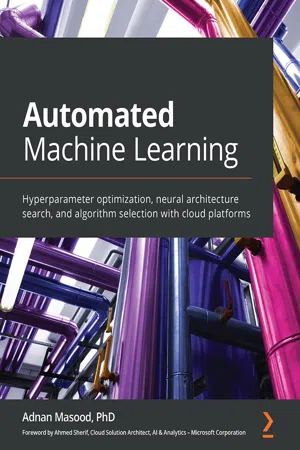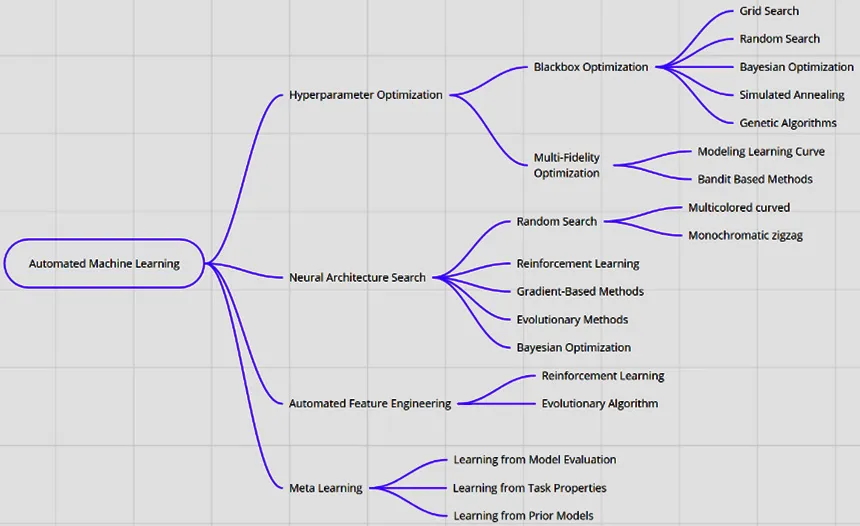
Automated Machine Learning
Hyperparameter optimization, neural architecture search, and algorithm selection with cloud platforms
Adnan Masood
- 312 pages
- English
- ePUB (mobile friendly)
- Available on iOS & Android
Automated Machine Learning
Hyperparameter optimization, neural architecture search, and algorithm selection with cloud platforms
Adnan Masood
About This Book
Get to grips with automated machine learning and adopt a hands-on approach to AutoML implementation and associated methodologies
Key Features
- Get up to speed with AutoML using OSS, Azure, AWS, GCP, or any platform of your choice
- Eliminate mundane tasks in data engineering and reduce human errors in machine learning models
- Find out how you can make machine learning accessible for all users to promote decentralized processes
Book Description
Every machine learning engineer deals with systems that have hyperparameters, and the most basic task in automated machine learning (AutoML) is to automatically set these hyperparameters to optimize performance. The latest deep neural networks have a wide range of hyperparameters for their architecture, regularization, and optimization, which can be customized effectively to save time and effort.
This book reviews the underlying techniques of automated feature engineering, model and hyperparameter tuning, gradient-based approaches, and much more. You'll discover different ways of implementing these techniques in open source tools and then learn to use enterprise tools for implementing AutoML in three major cloud service providers: Microsoft Azure, Amazon Web Services (AWS), and Google Cloud Platform. As you progress, you'll explore the features of cloud AutoML platforms by building machine learning models using AutoML. The book will also show you how to develop accurate models by automating time-consuming and repetitive tasks in the machine learning development lifecycle.
By the end of this machine learning book, you'll be able to build and deploy AutoML models that are not only accurate, but also increase productivity, allow interoperability, and minimize feature engineering tasks.
What you will learn
- Explore AutoML fundamentals, underlying methods, and techniques
- Assess AutoML aspects such as algorithm selection, auto featurization, and hyperparameter tuning in an applied scenario
- Find out the difference between cloud and operations support systems (OSS)
- Implement AutoML in enterprise cloud to deploy ML models and pipelines
- Build explainable AutoML pipelines with transparency
- Understand automated feature engineering and time series forecasting
- Automate data science modeling tasks to implement ML solutions easily and focus on more complex problems
Who this book is for
Citizen data scientists, machine learning developers, artificial intelligence enthusiasts, or anyone looking to automatically build machine learning models using the features offered by open source tools, Microsoft Azure Machine Learning, AWS, and Google Cloud Platform will find this book useful. Beginner-level knowledge of building ML models is required to get the best out of this book. Prior experience in using Enterprise cloud is beneficial.
Frequently asked questions
Information
Section 1: Introduction to Automated Machine Learning
- Chapter 1, A Lap around Automated Machine Learning
- Chapter 2, Automated Machine Learning, Algorithms, and Techniques
- Chapter 3, Automated Machine Learning with Open Source Tools and Libraries
Chapter 1: A Lap around Automated Machine Learning
- The ML development life cycle
- Automated ML
- How automated ML works
- Democratization of data science
- Debunking automated ML myths
- Automated ML ecosystem (open source and commercial)
- Automated ML challenges and limitations
The ML development life cycle

Automated ML

How automated ML works
Table of contents
- Automated Machine Learning
- Foreword
- Preface
- Section 1: Introduction to Automated Machine Learning
- Chapter 1: A Lap around Automated Machine Learning
- Chapter 2: Automated Machine Learning, Algorithms, and Techniques
- Chapter 3: Automated Machine Learning with Open Source Tools and Libraries
- Section 2: AutoML with Cloud Platforms
- Chapter 4: Getting Started with Azure Machine Learning
- Chapter 5: Automated Machine Learning with Microsoft Azure
- Chapter 6: Machine Learning with AWS
- Chapter 7: Doing Automated Machine Learning with Amazon SageMaker Autopilot
- Chapter 8: Machine Learning with Google Cloud Platform
- Chapter 9: Automated Machine Learning with GCP
- Section 3: Applied Automated Machine Learning
- Chapter 10: AutoML in the Enterprise
- Other Books You May Enjoy